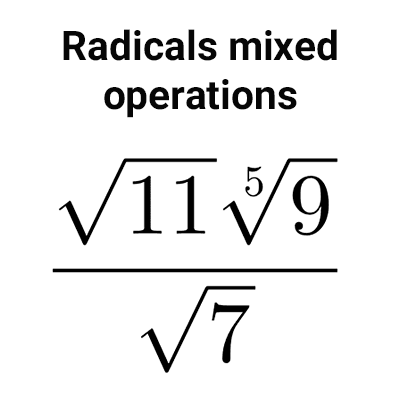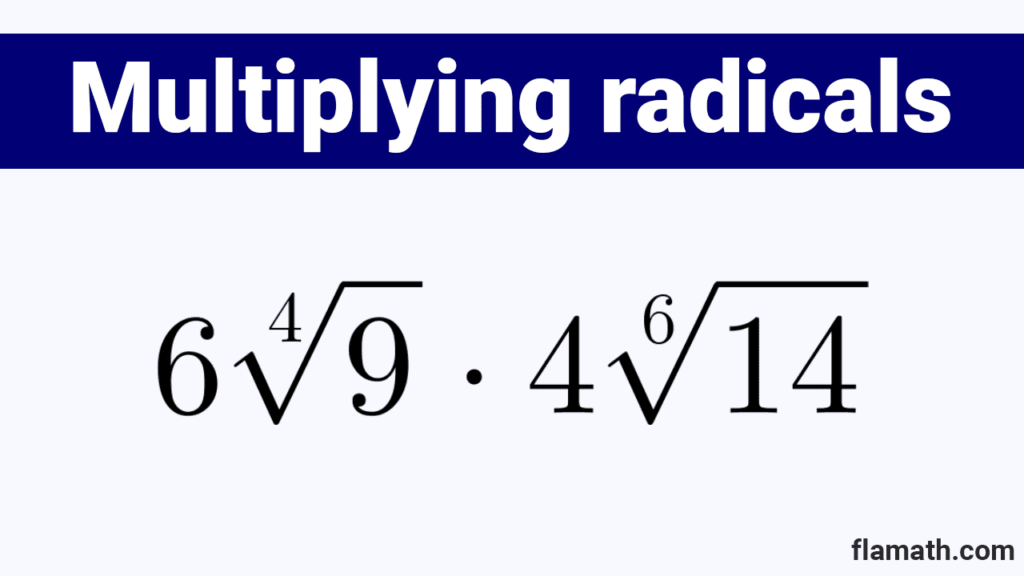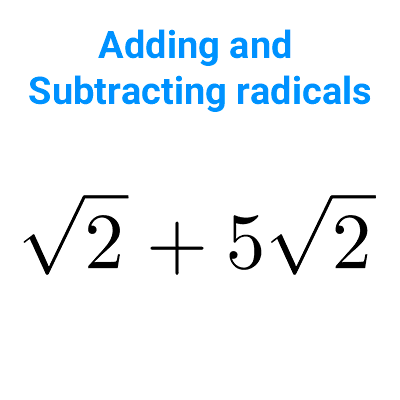
Multiplication of radical expressions
In this article we explain how to solve root multiplication step by step with examples. We will see the case where the roots have the same index and the case where they are different.
Table of Contents
What is the multiplication of radicals
Multiplication of radicals is an operation that involves multiplying two or more expressions containing roots (radical symbols). To perform the multiplication, it is important to know some mathematical properties that facilitate the process.
The most commonly used property tells us that the product of two roots with the same index can be written as the root of the product of the radicands.
*\sqrt[n]{a}\cdot \sqrt[n]{b}=\sqrt[n]{a\cdot b}* as long as *\sqrt[n]{a}* and *\sqrt[n]{b}* exist.
How to multiply radicals with the same index
Two or more radicals are called homogeneous when they have the same index. The constants multiplied by the radical are called coefficients.
For example, the expression *2\sqrt{20}\cdot 6\sqrt{5}* contains homogeneous radicals; their coefficients are *2* and *6* respectively.
To multiply radicals with the same index, keep the index the same, and multiply the coefficients and the radicands separately, with the latter integrated within the same root.
*\sqrt[n]{a}\cdot \sqrt[n]{b}=\sqrt[n]{a\cdot b}*
*p\sqrt[n]{a}\cdot q\sqrt[n]{b}=p\cdot q\sqrt[n]{a\cdot b}*
Example 1
*2\sqrt{20}\cdot 6\sqrt{5}*
We identify that the radicals have the same index (remember that when the index is not visible, it is 2, meaning we have a square root). With this in mind, we multiply coefficient by coefficient and integrate the radicands within the same root.
*2\sqrt{20}\cdot 6\sqrt{5}=(2\cdot 6)\sqrt{20}\sqrt{5}*
*=12\sqrt{20\cdot 5}*
*=12\sqrt{100}*
*=12\cdot 10*
*=120*
Example 2
*-4\sqrt[3]{5}\cdot 3\sqrt[3]{-4}*
In the expression, there are two homogeneous roots since they have the same index. We proceed to multiply the coefficients together and the radicands within the same root, following the law of signs.
*-4\sqrt[3]{5}\cdot 3\sqrt[3]{-4}=-4\cdot 3\sqrt[3]{5\cdot (-4)}*
*=-12\sqrt[3]{-20}*
Remember that the cube root of a negative number is a real number. However, if we had the square root (or any even index) of a negative number, we couldn't perform the operation as they are not real numbers.
Example 3
*\sqrt{5}\sqrt{2}\sqrt{2}*
In this example, we have three square roots, and all coefficients are 1. We solve the operation by multiplying all the radicands within the same root.
*\sqrt{5}\sqrt{2}\sqrt{2}=\sqrt{5\cdot 2\cdot 2}=\sqrt{20}*
Once we obtain the result, it is convenient to extract factors if possible, to simplify the radical. In this case:
*\sqrt{5}\sqrt{2}\sqrt{2}=\sqrt{20}*
*=\sqrt{2^2\cdot 5}*
*=\sqrt{2^2}\sqrt{5}*
*=2\sqrt{5}*
Example 4
*\sqrt{7}\cdot (\sqrt{8}+\sqrt{11})*
In the example, there is multiplication of a radical by a sum enclosed in parentheses. We can use the distributive property to solve it.
*\sqrt{7}\cdot (\sqrt{8}+\sqrt{11})=\sqrt{7}\sqrt{8}+\sqrt{7}\sqrt{11}*
*=\sqrt{7\cdot 8}+\sqrt{7\cdot 11}*
*=\sqrt{56}+\sqrt{77}*
*=2\sqrt{14}+\sqrt{77}*
If possible, perform the sum of the roots. In this example, this couldn't be done.
Example 5
*\sqrt{7}\cdot \sqrt{7}*
In this case, we have the multiplication of two roots that are the same. We proceed as usual:
*\sqrt{7}\cdot \sqrt{7}=\sqrt{7\cdot 7}*
*=\sqrt{7^2}*
*=7*
The result obtained is the same radicand. This is true in general whenever the roots are multiplied by themselves as many times as their index. There's an added condition when the index is an even number: the radicand cannot be negative; if the index is odd, this restriction does not apply. For square and cubic roots, the following applies:
- Multiplying a square root by itself once results in the radicand, provided it is not negative: $$\sqrt{a}\cdot \sqrt{a}=(\sqrt{a})^2=a~~~(a>0)$$
- Multiplying a cubic root by itself three times results in the radicand: $$\sqrt[3]{a}\cdot \sqrt[3]{a}\cdot \sqrt[3]{a}=(\sqrt[3]{a})^3=a$$
Note: Requiring the radicand not to be negative when the index is even is equivalent to requiring the root to be a real number.
Example 6
*\sqrt{13}\cdot (a+b\sqrt{7})*
When there are variables (letters) within the parenthesis, either in the coefficients or as part of the radicand, the procedure to solve the multiplication remains the same.
*\sqrt{13}\cdot (a+b\sqrt{7})=a\sqrt{13}+b\sqrt{13}\sqrt{7}*
*=a\sqrt{13}+b\sqrt{91}*
Practice exercises: solve the following multiplications.
- *\sqrt{28}\cdot \sqrt{7}*
- *(\sqrt{4}+\sqrt{8})\cdot \sqrt{2}*
- *-4\sqrt[3]{5}\cdot \sqrt[3]{4}*
Solutions:
- *\sqrt{28}\cdot \sqrt{7}=\sqrt{28\cdot 7}=\sqrt{196}=14*
- *(\sqrt{4}+\sqrt{8})\cdot \sqrt{2}=\sqrt{4}\sqrt{2}+\sqrt{8}\sqrt{2}=\sqrt{8}+\sqrt{16}=2\sqrt{2}+4*
- *-4\sqrt[3]{5}\cdot \sqrt[3]{4}=-4\sqrt[3]{5\cdot 4}=-4\sqrt[3]{20}*
How to multiply radicals with different indexes
Two or more radicals are called heterogeneous when they have different indexes.
For example, *\sqrt[3]{2}* and *\sqrt{2}* are heterogeneous radicals because one is a cubic root and the other is a square root.
To multiply radicals with different indexes, it's necessary to first homogenize them (make the indexes equal), and then perform the multiplication as we saw earlier.
The process of homogenizing involves calculating the least common multiple (LCM) of the different indexes and converting the roots into an expression with equal indexes, using the following property:
If you multiply both the index and the exponent of a root by the same positive integer, the new root obtained is equivalent to the original one.
*\sqrt[n]{a}=\sqrt[n\cdot k]{a^k}*
The procedure to homogenize radicals (equalize their indices) is:
- Find the least common multiple of the indexes.
- Divide the LCM by each of the original indexes.
- Multiply the value obtained in the previous step by the original indexes and the exponent of the corresponding radicand. This will equalize the indexes.
Example 1
*\sqrt{7}\cdot \sqrt[3]{5}*
The indexes are different, so they need to be equalized.
1. Calculate the least common multiple (LCM) between the indexes: *LCM(2,3)=6*
2. Divide this number by each of the indexes:
For the first root: *\dfrac{6}{2}=3*
For the second root: *\dfrac{6}{3}=2*
3. Multiply the numbers obtained in the previous step by the original indexes and the exponent of the corresponding radicand:
First root: *\sqrt[2\cdot 3]{7^3}=\sqrt[6]{343}*
Second root: *\sqrt[3\cdot 2]{5^2}=\sqrt[6]{25}*
We have found roots equivalent to the original ones, both with the same index, and now we can perform the multiplication:
*\sqrt{7}\cdot \sqrt[3]{5}=\sqrt[6]{343}\cdot \sqrt[6]{25}*
*=\sqrt[6]{343\cdot 25}*
*=\sqrt[6]{8575}*
Example 2
*6\sqrt[4]{9}\cdot 4\sqrt[6]{14}*
We find the LCM of the indexes: *LCM (4,6)=12*
We divide the LCM by each of the indexes:
First root: *\dfrac{12}{4}=3*
Second root: *\dfrac{12}{6}=2*
Now we multiply the number obtained in each case by the index and the exponent of the corresponding root:
First root: *\sqrt[4\cdot 3]{9^3}=\sqrt[12]{729}*
Second root: *\sqrt[6\cdot 2]{14^2}=\sqrt[12]{196}*
Finally, with the indexes equalized, we can perform the multiplication by replacing the roots in the original expression.
*6{\color{green}\sqrt[4]{9}}\cdot 4{\color{purple}\sqrt[6]{14}}=6{\color{green}\sqrt[12]{729}}\cdot 4{\color{purple}\sqrt[12]{196}}*
*=24\sqrt[12]{729\cdot 196}*
*=24\sqrt[12]{142884}*
A practical way to find the least common multiple is to calculate the product of the common and uncommon factors in the prime factorization of the numbers in question, with their highest exponent.
For example, to find the LCM between *8* and *14*, we break down both into prime factors:
*8=2^3*
*14=2\cdot 7*
The different factors that appear are *7* and *2*, the highest exponent of the latter number is *3,* so:
*LCM(8,14)=7\cdot 2^3=56*
Practice exercises: solve the following multiplications.
- *\sqrt{3} \cdot \sqrt[3]{5}*
- *\sqrt{6} \cdot (-5\sqrt[4]{2})*
- *\sqrt[3]{2} \cdot \sqrt[4]{3}*
Solutions:
- *\sqrt{3} \cdot \sqrt[3]{5}=\sqrt[6]{3^3}\cdot \sqrt[6]{5^2}=\sqrt[6]{3^3\cdot 5^2}=\sqrt[6]{225}*
- *\sqrt{6} \cdot (-5\sqrt[4]{2})=-5\sqrt[4]{6^2}\cdot \sqrt[4]{2}=-5\sqrt[4]{6^2\cdot 2}=-5\sqrt[4]{72}*
- *\sqrt[3]{2} \cdot \sqrt[4]{3}=\sqrt[12]{2^4}\cdot \sqrt[12]{3^3}=\sqrt[12]{2^4\cdot 3^3}=\sqrt[12]{432}*
FAQs
How to multiply radicals with the same index?
To multiply radicals with the same index, the index is kept and the coefficients and radicands are multiplied separately, the latter integrated within the same root.
Is it possible to multiply radicals of different index?
Radicals of different index can be multiplied, but first it is necessary to homogenize them, that is, to make them have the same index.
How to multiply radicals with different indexes?
To multiply radicals with different indexes, it is first necessary to homogenize them (equalize the indexes), then perform the usual product.
What are equivalent radicals?
Two radicals are equivalent if one can be obtained from the other by multiplying the index and the exponent by the same positive integer.
What properties are used for the multiplication of radicals?
The most commonly used property for multiplying radicals is that the product of two roots of the same index can be written as the root of the product of the radicands.

<?php
function insertar_script_en_singles() {
if (is_single()) {
echo '<script async src="https://pagead2.googlesyndication.com/pagead/js/adsbygoogle.js?client=ca-pub-2454918494658385"
crossorigin="anonymous"></script>';
}
}
add_action('wp_footer', 'insertar_script_en_singles');
function insertar_anuncio_antes_segundo_h2($content) {
if (is_single()) {
$script_anuncio = '<ins class="adsbygoogle"
style="display:block"
data-ad-client="ca-pub-2454918494658385"
data-ad-slot="6539672124"
data-ad-format="auto"
data-full-width-responsive="true"></ins>
<script>
(adsbygoogle = window.adsbygoogle || []).push({});
</script>';
$pattern = '/(<h2(.*?)>)/i';
if (preg_match_all($pattern, $content, $matches, PREG_OFFSET_CAPTURE) >= 2) {
$second_h2_position = $matches[0][1][1];
$content = substr_replace($content, $script_anuncio, $second_h2_position, 0);
}
}
return $content;
}
add_filter('the_content', 'insertar_anuncio_antes_segundo_h2');
function insertar_anuncio_antes_cuarto_h2($content) {
if (is_single()) {
$script_anuncio = '<ins class="adsbygoogle"
style="display:block"
data-ad-client="ca-pub-2454918494658385"
data-ad-slot="2169244946"
data-ad-format="auto"
data-full-width-responsive="true"></ins>
<script>
(adsbygoogle = window.adsbygoogle || []).push({});
</script>';
$pattern = '/(<h2(.*?)>)/i';
if (preg_match_all($pattern, $content, $matches, PREG_OFFSET_CAPTURE) >= 4) {
$fourth_h2_position = $matches[0][3][1];
$content = substr_replace($content, $script_anuncio, $fourth_h2_position, 0);
}
}
return $content;
}
add_filter('the_content', 'insertar_anuncio_antes_cuarto_h2');
function insertar_anuncio_antes_sexto_h2($content) {
if (is_single()) {
$script_anuncio = '<ins class="adsbygoogle"
style="display:block"
data-ad-client="ca-pub-2454918494658385"
data-ad-slot="5491480651"
data-ad-format="auto"
data-full-width-responsive="true"></ins>
<script>
(adsbygoogle = window.adsbygoogle || []).push({});
</script>';
$pattern = '/(<h2(.*?)>)/i';
if (preg_match_all($pattern, $content, $matches, PREG_OFFSET_CAPTURE) >= 6) {
$sixth_h2_position = $matches[0][5][1];
$content = substr_replace($content, $script_anuncio, $sixth_h2_position, 0);
}
}
return $content;
}
add_filter('the_content', 'insertar_anuncio_antes_sexto_h2');


Other articles that may interest you